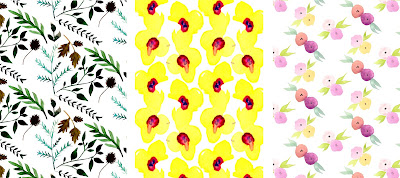17th Jan- 23rd Jan
As I have learnt from my last project that preparation for
the Print room is key, a lot of my time this week has been spent preparing and
mono printing. Figure 12 shows my prepared repeat patterns done on Photoshop as
guides for my painting on to screen as to minimalise mistakes and make the most
of the time I have in the Print room.
Fig. 12
 |
| Repeat Guides |
Colour is a really important to get right and therefore, I
have spent a lot of time mixing colours, recording the outcomes and printing
some colour tests onto the fabrics I am hoping to use. This colour experimentation
was really valuable as I learnt a lot about reactive dyes and what fabrics they
work on the best which informed my printing.
Although I have not applied the technique of mono printing
within my time at university a lot, I was surprised at how much I enjoyed doing
it. There is a lot of room for mistakes when painting on the screen as you can
just wash away the colour and paint over it. Although it was time consuming,
the outcomes are really effective and convey a quality on the fabric similar to
that of watercolour and have a certain authenticity to them. One sample shows
the autumn/winter collection, whereas the two other samples show a more
spring/summer collection.
In order to support the mono prints within a collection,
sublimation prints were made with my other repeat patters on Photoshop. This
also meant that the prints were made up from my original drawings which still
enabled the watercolour qualities to transfer onto the fabrics. A back up
technique such as digitally printing or sublimation printing is something I
always think about. When my Autumn/Winter mono print design was pushed through
the screen to transfer to fabric, residue from a previous printer was left on
the screen, blocking parts of the mesh. Therefore areas of my print could not
reach onto the fabric. However, due to having the digital back up plan I was
able to quickly print digital and sublimation samples to back up and support
the Autumn/Winter collection.
Fig. 13
 |
| Mono Print mistake |
Visualisations of the two different
collections were made in order to understand how each individual print could
work as a bedding set, whether it would work for the main duvet, the reverse of
the duvet, the pillow cases or the bed sheet as the same motifs and repeat
patterns can be used throughout a single bedding set seen in figure 14.
Fig. 14
 |
| Bed sets |
As I need to move on to my final project of the unit I do not have time to thoroughly think more into other bedroom furniture. However, making up visualisations can give me a rough idea on how my prints could work at different scales for lamps shades, chairs, cushions and wallpaper. This is something I can really start to think about in Unit X which could also inform the making up of a product for the degree show.
Fig. 15
 |
| Examples of furnishings |
Although I have produced a small collection for bedding,
there is a lot more mileage I can attain from my practice throughout this Unit
and apply it to future projects in Unit X such as screen printing techniques,
context research and painting skills. The thought of painting was a nerve
racking one until it worked well in this Unit. Therefore, hopefully I can start
to explore painting with different mediums more thoroughly in the next units/projects
to create more print collections.
Fig. 16




No comments:
Post a Comment